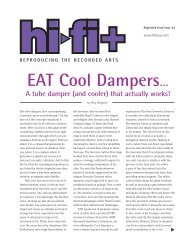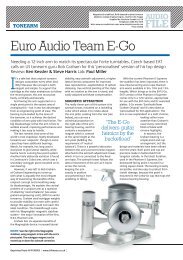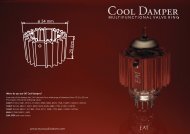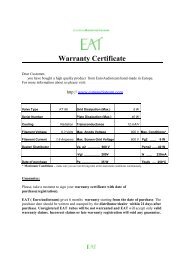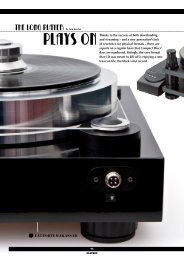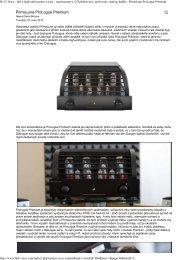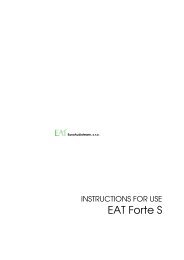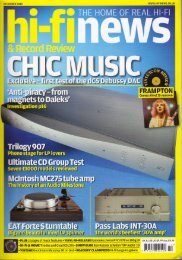Innerworld Audio - EAT Forte S turntable - EuroAudioTeam.com
Innerworld Audio - EAT Forte S turntable - EuroAudioTeam.com
Innerworld Audio - EAT Forte S turntable - EuroAudioTeam.com
You also want an ePaper? Increase the reach of your titles
YUMPU automatically turns print PDFs into web optimized ePapers that Google loves.
Sound consistency<br />
To start with I tried a good number of piano LPs to hear if I could detect any - just any - wow from the <strong>Forte</strong> S <strong>com</strong>bo. With piano music any wow would be irritating indeed, if<br />
present. But no wow whatsoever. The test passed. And general speaking, the <strong>Forte</strong> S <strong>com</strong>bo did not have an erroneous kind of sound but its opposite. No flutter either, althoug I<br />
think flutter is less of a risk with this type of <strong>turntable</strong> construction.<br />
The speed variance of <strong>EAT</strong> <strong>Forte</strong> S is, according to the manufacturer, +/- 0,09%. But it's not just that technical speed stability that matters. When my daughter practices cello, I often<br />
ask her, before she adds any slow/fast variations of her own, to play the piece first as if she were a metronome, like a bulldozer, keeping timing and tempo razor sharp, instead of<br />
"quite correct". It is quintessential for musical satisfaction that a turtable behaves like a bulldozer, rushing through the piece respecting the fundamental temporal progression at the<br />
bottom of the <strong>com</strong>position. This I guess is one of the major reasons why idler-driven TTs are so liked in some corners, and I very, very much liked what the <strong>Forte</strong> S was able to do in<br />
this regard.<br />
Yet another thing. Have you noticed how fast the actual tempo often is in pop and rock songs (take the Beatles, for example), even in the slower ones? The fact is easy to confirm by<br />
trying to play the same song by oneself at the original tempo; time and again I'm amazed by the chosen tempo on the recording, and how fast it is as <strong>com</strong>pared to the perceived one,<br />
just like hymn singing church-goers lag behind the tempo suggested by the cantor. The better TT, the more directly it conveyes the actual, fast tempo of the songs. The <strong>Forte</strong> S is<br />
such a <strong>turntable</strong>.<br />
As to softness/coldness of the tone, which I associate mainly with the qualities of the cartridge, the <strong>Forte</strong> S/Yosegi <strong>com</strong>bo delivered quite a nice package of mellowness/roundness<br />
on one hand, and sharper accuracy/resolution on the other. Yosegi ain't Ortofon SPU or EMT TDS-15 (not even with van den Hul stylus profile), it ain't like the Benz precision<br />
instruments either. It's somewhere in the middle, featuring a little bit of the best of the two worlds. That suited to my personal likings perfectly, but that's only me.<br />
As to definition/timbre, let me just say this. No one should <strong>com</strong>e and tell how a guitar ought to sound, or a violin or a clarinet or any other instrument ought to sound before he or<br />
she has heard how the instrument in question sounds on the original LP through a quality <strong>turntable</strong> system. And I'm not at all talking about the "true color" of the tone estimated by<br />
some vague reference to some long gone concert event; I'm talking about how the sound feels. With a well-made <strong>turntable</strong> it feels - it felt - so good and right. I doubt it can never feel<br />
the same in the digital domain.<br />
The bass department was also surprisingly good although I know <strong>turntable</strong>/tonearm/cartridge <strong>com</strong>binations that can dig the bass out of the groove equally convincingly. Here my<br />
verdict is that to the extent the bass quality depends on the <strong>turntable</strong> itself, there's no need to worry.<br />
However, I want to stress again and again that properties related to the quality of the bass, treble, mid-range, sound-stage etc. are always of minor importance as <strong>com</strong>pared to what<br />
the <strong>turntable</strong> can do or cannot do with matters relating to music's temporal progression. And in this regard this <strong>EAT</strong> <strong>com</strong>bination including the <strong>EAT</strong> <strong>Forte</strong> S <strong>turntable</strong> & <strong>EAT</strong> Yosegi<br />
cartridge & <strong>EAT</strong>-312 tonearm is really, really a <strong>com</strong>petent one, smooth and still vivid sounding, such a joy to the ear. Sonically the <strong>EAT</strong> <strong>Forte</strong> S reminded me of superb sounding<br />
Verdier <strong>turntable</strong>s, which to those who know Verdier <strong>turntable</strong>s, tells a lot.<br />
In conclusion<br />
The <strong>EAT</strong> <strong>Forte</strong> S together with the <strong>EAT</strong>-312 tonearm and Yosegi cartridge cost about eight nine thousand euros. It's not within possibilities of most us but still, I'd say, <strong>com</strong>petitive.<br />
It's a <strong>com</strong>bination for the rest of one's life. The <strong>turntable</strong> itself is of so high quality, technically and sonically, that I'd stop looking for a better. No doubt there's a whole bunch of<br />
"better" and pricier <strong>turntable</strong>s on the market, but I'd rather put my energy and efforts in finding a tonearm/cartridge <strong>com</strong>bination that maximally <strong>com</strong>pliments both the <strong>Forte</strong> S and<br />
the taste. My taste was well served with the <strong>EAT</strong>-312 tonearm. It's a tempting choice also because it enables having five or six different cartridges, including mono ones, fixed in<br />
their own headshell, and then changing the cartridge according to music genre, recording, time of the day, the weather, and so forth.<br />
The major difference between the <strong>EAT</strong> <strong>Forte</strong> S <strong>com</strong>bo and lesser <strong>turntable</strong>s is that with the former it be<strong>com</strong>es so obvious that the digital sound can never be equally touching and<br />
real as the vinyl sound. No same charm, no same magic.<br />
<strong>EAT</strong> <strong>Forte</strong> S, Makassar without tonearm 5.070 EUR; <strong>EAT</strong> <strong>Forte</strong> S, Piano Black without tonearm 4.470 EUR; <strong>EAT</strong> <strong>Forte</strong> S, Makassar with ProJect 12" cc EVO 5.970 EUR; <strong>EAT</strong><br />
<strong>Forte</strong> S, Piano Black with ProJect 12" cc EVO 5.370 EUR; <strong>EAT</strong> Yosegi cartrdige, 1.550 EUR; <strong>EAT</strong> Yosegi headshell 555 EUR; <strong>EAT</strong> 312 12" tonearm 2.490 EUR; <strong>EAT</strong> <strong>Forte</strong> S<br />
Acrylic Dust Cover 495 EUR.<br />
www.stereohelsinki.fi<br />
www.euroaudioteam.<strong>com</strong><br />
www.scanteknik.fi<br />
<strong>EAT</strong> Yosegi Specifications:<br />
Cartridge type: Moving-coil<br />
Frequency response: 15-50kHz<br />
1.12.2012 1:07




